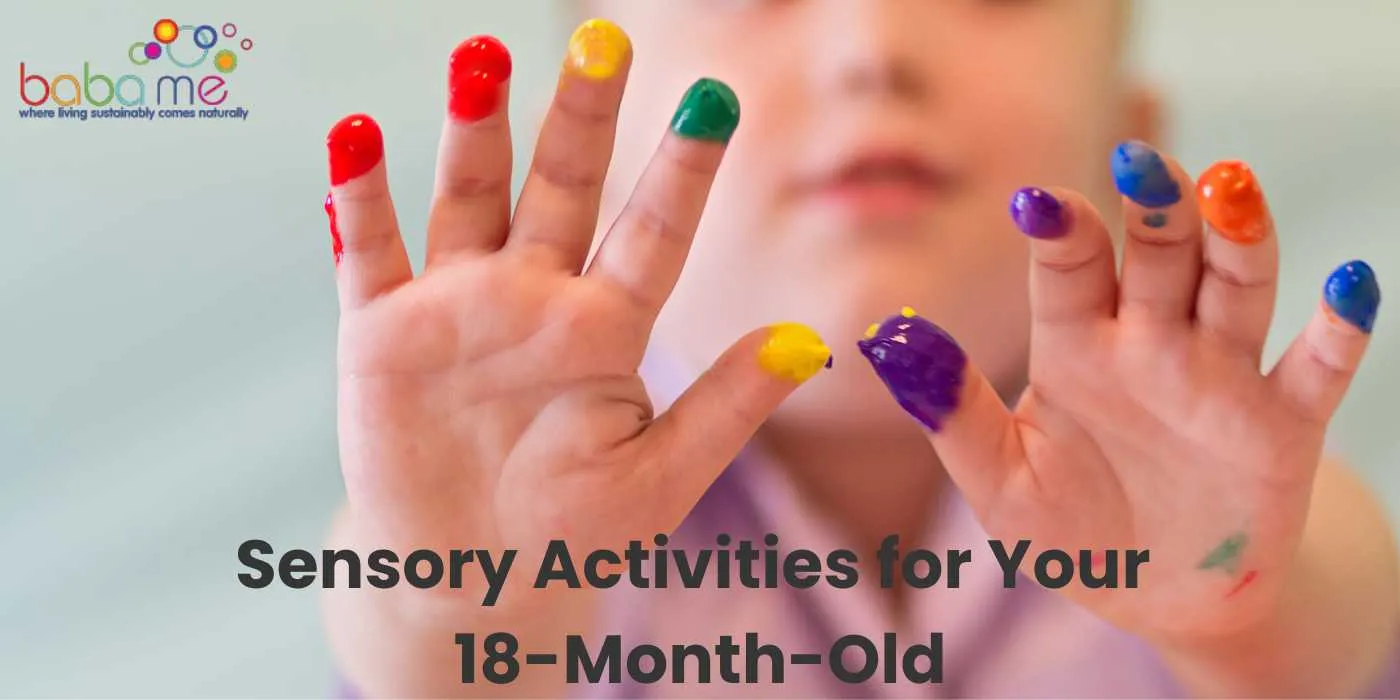Are you ready to dive into a world of discovery, imagination, and excitement with your little explorer?
The first few years of your child’s life are a time of rapid growth and development, with every day bringing new experiences. One of the most effective ways to stimulate this growth is through sensory play.
From the simple splash of water to the magical dance of shadow puppets, sensory activities engage your child’s senses, enrich their understanding of the world, and nurture a variety of developmental skills. With this list of 30 Sensory Activities, you can offer your 18-month-old a new adventure every day of the month!
What Are Sensory Activities For Kids
Sensory activities are designed to engage children’s senses including touch, smell, taste, sight, and hearing. These activities are vital to children’s development because they not only stimulate their senses but also encourage the development of cognitive, linguistic, social, emotional, physical, and creative skills.
Sensory activities could be anything from playing with sand or water, smelling various scents, tasting new foods, listening to different sounds or engaging with visually stimulating objects. They are meant to be fun, engaging, and exploratory experiences for children to learn and grow.
By involving children in sensory activities, we’re helping them explore their world in a safe and playful environment, aiding in their understanding and management of their sensory experiences.
List Of 30 Sensory 18 Month Old Activities
I’ve given you one for every day of the month, so lets dive right in with some fun ideas for both gross motor activities and sensory play!

Painting With Water
I’ve got a fun, mess-free activity that’s perfect for those days when you’re not up for scrubbing paint off every surface (we’ve all been there, right?). I call it Painting With Water.
All you need is a small bowl of water, a paintbrush, and a driveway or sidewalk that could use a little creative flair. Hand the paintbrush to your tot, show them how to dip it in the water, and let them “paint” to their heart’s content. The water evaporates quickly, but that’s part of the magic – they can create endless masterpieces without the cleanup!
While they’re having a blast, they’ll be practicing their fine motor skills and hand-eye coordination, and learning about cause and effect as they see their designs disappear. Plus, it’s a fantastic way to cool down on a hot day.
This is a such a fun way to incorporate sensory exploration with hand eye coordination, developing both fine motor development and sensory fun.
Magnetic Letters On Cooking Sheet
It’s super easy to set up, loads of fun, and sneakily educational!
Here’s how we do it: Grab a bunch of magnetic letters (the colorful ones are a big hit with my kiddo!) and a metal cookie sheet. Spread the letters out and let your toddler arrange them on the cookie sheet. They’ll be thrilled to see the letters stick!
As your little one explores and experiments with these magnetic letters, they’re working on their fine motor skills, letter recognition, and even the basics of spelling if they’re ready. It’s amazing to see their little faces light up when they recognize a letter from their name or when they randomly spell a word!

Noodles & Straws
To set this up, all you need is a handful of straws and some ring-shaped cereal or pasta. I usually use cheerios, but any pasta rings work too.
Now, invite your kiddo to thread the noodles onto the straws. Sounds simple, right? But you’ll be amazed at how much they love it! It’s like a fun mini-challenge for their tiny hands, and the look of triumph on their faces when they manage to get a noodle on the straw is just priceless!
The best part? While they’re having a blast with this fun game, they’re also developing their fine motor skills and problem-solving abilities. Plus, if you’re using colored straws or cereal, it’s a great chance to teach them about colors.
Card Drop
To set up the Card Drop activity, find an old cardboard box and cut slits big enough for a card to fit through. Then, give your 18-month-old a deck of cards to ‘post’ through these slits. This simple yet engaging activity aids in developing fine motor skills, as your toddler will need to use their little fingers to grasp and manipulate the cards.
It also promotes hand-eye coordination, as they aim to post the card through the slit. Besides, Card Drop offers a fun way to introduce basic problem-solving, as your child figures out how to get the card through the slot.
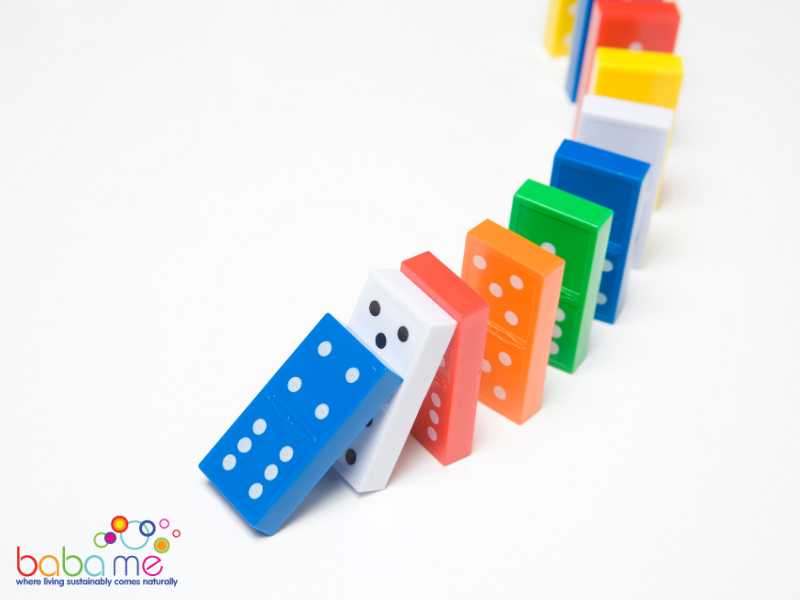
Domino Delight
Gather a set of dominoes. Show your toddler how to line them up just right – close enough to touch but not too tight. Once they’ve got a nice long line (or a crazy zigzag, because who doesn’t love those?), let them push the first domino and watch as the rest follow suit in a delightful domino tumble. The giggles are guaranteed!
The tactile sensation of the dominoes, the visual spectacle of the falling tiles, and the gentle clattering sound they produce enriches their sensory experience.
Not only is this loads of fun, but it’s also a fantastic way to boost fine motor skills as they place each domino carefully. It promotes hand-eye coordination and even introduces them to the concept of cause and effect, and honestly it was such a hit with my boys.
Play Dough Fun
This colorful, squishy stuff can offer endless entertainment and learning for our little ones.
First, grab some play dough – store-bought or homemade (bonus: making it together can be an activity in itself!). Then let your child’s imagination run wild. They can squish it, roll it, shape it, cut it – the possibilities are endless!
This activity is a sensory smorgasbord. The soft, moldable texture of play dough provides a rich tactile experience, and the vibrant colors are a feast for the eyes. Plus, manipulating the dough is excellent for developing fine motor skills and hand-eye coordination.
Not to mention, it’s an incredible outlet for creativity. Whether they’re making their favorite animals or just enjoying the process of exploration and creation, they’re learning and growing.

Doodle Fun With Chalk
Grab a pack of vibrant sidewalk chalk and head outside with your toddler. Show them how they can make their mark on the world by doodling on the driveway, the sidewalk, or even a safe spot on a wall. They’ll love seeing the different colors they can create, and the way they can make their imagination come to life!
This activity is a sensory superstar. The touch of chalk, the bright colors, and even the gentle scrape it makes against the ground all add up to a sensory feast for your little one. Plus, it’s great for their fine motor skills as they grasp and manipulate the chalk.
And let’s not forget – it’s a great way for them to express their creativity and have some fun in the sun. Just remember to have some water on hand for when they’ve had enough and it’s time to wash their masterpieces away.
Play with Pipe Cleaners
This flexible and colorful craft staple can open a world of sensory and imaginative fun for your little one.
Hand your 18-month-old a bunch of pipe cleaners. They can bend them, twist them, make loops, or even thread them through a colander’s holes. Each new shape and configuration is a fresh discovery!
Engaging with pipe cleaners offers a unique tactile experience. The fuzzy texture combined with the bendable nature of pipe cleaners gives your little one an intriguing ‘touch’ sensation. This activity also sparks creativity and problem-solving while strengthening their fine motor skills and hand-eye coordination.
Best part? Cleanup is a breeze!

Jumping on a blanket
This one is as simple as it sounds. Lay a soft, large blanket on the floor and let your toddler jump, stomp, or dance on it. To make it even more exciting, you could fold the blanket to create different textures and levels.
Jumping on a blanket not only helps burn off that endless toddler energy but also offers a wonderful sensory experience. The soft texture of the blanket under their little feet, the sound of their giggles, and the physical sensation of jumping combine to engage multiple senses. Plus, it’s a fantastic way to develop gross motor skills and balance!
Sensory Bin
This is a fantastic hands-on experience that you can easily tailor to your toddler’s interests and developmental stage.
Begin by choosing a large, shallow bin. Then fill it with a variety of textures for your little one to explore. This could include materials like rice, dry beans, cooked spaghetti, water beads, pom poms, or anything else that is safe and interesting to touch. You can even add small toys or everyday items for them to discover!
The Sensory Bin offers a rich, tactile experience that can also stimulate visual and even auditory senses, depending on the materials used. Plus, the action of digging, scooping, and searching helps improve fine motor skills and hand-eye coordination. It’s also a great opportunity for them to practice focus and patience as they engage with the bin’s contents.
Finger Painting
This timeless, joyful activity is not just fun but also a sensory wonderland for our little ones.
For this activity, you’ll need some non-toxic, washable paints and large sheets of paper. Tape the paper down to a surface for stability, pour a little paint into shallow dishes, and let your toddler dip their fingers and make their masterpiece.
Finger Painting provides a fantastic tactile experience as your child feels the paint squish between their fingers. The vibrant colors stimulate their visual senses, and the act of painting enhances their fine motor skills and hand-eye coordination. It’s also a wonderful creative outlet and an early introduction to the world of art!

Bubble Wrap Stomp
To start, simply spread a sheet of bubble wrap on a flat surface. Let your little one walk, run, jump, or dance on the bubble wrap, making those irresistible popping sounds. Make sure they’re barefoot for a better feel of the texture!
Bubble Wrap Stomp is a sensory blast! It offers a unique tactile experience as your toddler feels the bubbles pop under their feet. The popping sounds engage their auditory senses, and the act of stomping and balancing helps develop gross motor skills. Plus, it’s an absolute blast that guarantees giggles!
Edible Sensory Play
Edible sensory play can be as simple as letting your little one play with cooked pasta, explore the wobbly world of Jello, or even squish some edible slime made from cornstarch and juice. Just remember to keep a watchful eye and ensure everything is safe for consumption!
Edible Sensory Play is a sensory delight! Your toddler gets to experience various textures, temperatures, and tastes, providing a unique sensory experience that tickles all their senses. It can also introduce them to new foods in a fun, pressure-free way and can help improve their fine motor skills as they pinch, squeeze, and scoop.

Music Time
Let’s strike a chord with our next sensory activity – Music Time!
Music Time can be as simple or elaborate as you like. You could use store-bought musical instruments like a xylophone, drum, or maracas. Or better yet, create your own orchestra at home with pots and pans, spoons, or DIY shakers made from plastic containers filled with rice or beans.
Music Time is a symphony of sensory stimulation. Your toddler gets to hear the various sounds they can create, feel the vibration of the instruments, and see the physical effect of their actions. This activity enhances auditory skills, fine motor skills, and coordination. Plus, it’s an excellent introduction to rhythm and melody and will keep a toddler entertained!
Nature Exploration
Nature Exploration can be as simple as stepping into your backyard, local park, or any outdoor space available. Encourage your little one to touch different textures like leaves, grass, and tree bark. Listen together to the sounds of birds singing, leaves rustling, or water flowing. Collect interesting objects like stones, twigs, or pinecones.
Nature Exploration is an absolute sensory feast! The varied textures, colors, and sounds of nature provide rich sensory experiences. This activity also encourages curiosity and a love for nature, enhancing cognitive and motor skills as your toddler navigates and interacts with the outdoor world.
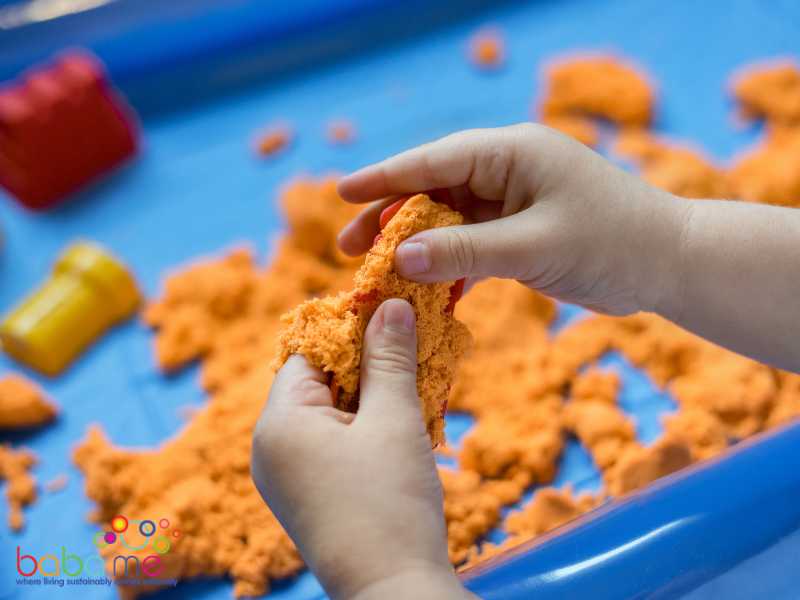
Sand Play
Sand Play can be as simple as filling a small bin or kiddie pool with play sand. Add some beach toys, buckets, or even just some kitchen utensils, and let your little one dig, scoop, pour, and mold to their heart’s content.
Sand Play offers a unique tactile experience that’s both calming and engaging. Your toddler can feel the grains of sand running through their fingers, see the mounds they create, and hear the soft whoosh of sand falling. This activity helps develop fine motor skills, encourages creativity, and offers a fantastic introduction to early physics concepts like volume and gravity.
Water Play
Water Play is as simple as filling up a basin, inflatable pool, or even your bathtub. Add some bath toys, cups, funnels, and watch as your little one pours, splashes, and enjoys the cool sensation of water.
Water Play is a sensory delight! The sensation of water, its movement, the sounds it makes, all provide rich sensory input. This activity encourages fine and gross motor skill development as they scoop, pour, and splash. It’s also an early introduction to the concepts of volume, cause and effect.
So, let’s roll up those sleeves and jump into the watery world of Water Play! I can’t wait to hear about your toddler’s aquatic adventures. Remember, the biggest splashes often lead to the biggest smiles!
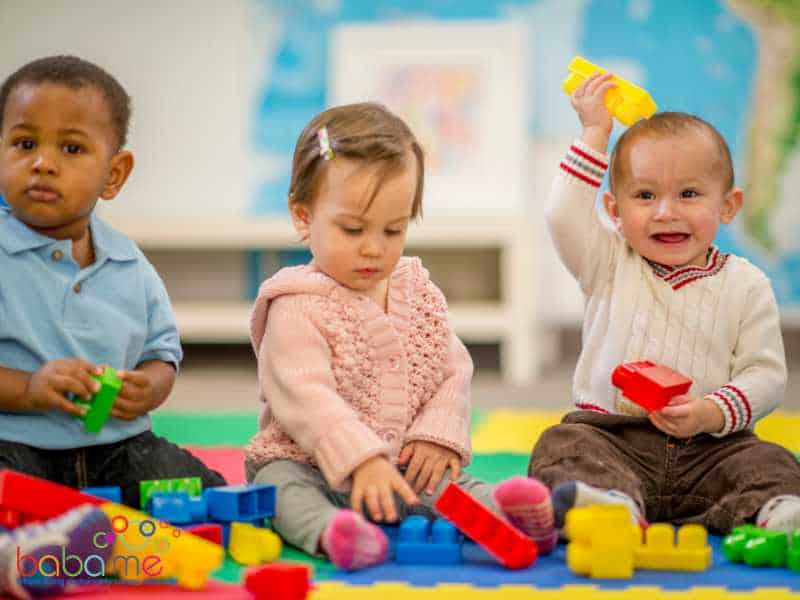
Stacking Blocks
Stacking Blocks is as simple as it sounds. All you need is a set of blocks; they can be wooden, plastic, or even soft fabric blocks. Then, let your little one stack them up, knock them down, and start all over again!
Stacking Blocks offers a great tactile experience as your child feels the texture, shape, and weight of the blocks. It’s a visually stimulating activity, especially if the blocks are colorful or have different patterns. Plus, this activity is wonderful for developing fine motor skills, hand-eye coordination, and introducing early concepts of size and balance.
Tissue Box Monster
For the Tissue Box Monster, all you need is an empty tissue box, some colored paper, glue, and googly eyes. Transform the box into a ‘monster’ by decorating it with paper teeth, tongue, and eyes. Then, fill it with fluffy pompoms or soft fabrics, and encourage your little one to feed or retrieve items from the monster’s mouth.
The Tissue Box Monster provides a tactile experience as your child explores the texture of the box, the paper, and the items inside. It’s also a great visual stimulation and an engaging way to practice fine motor skills as they pick up and drop items into the box.
Textured Crawling
For Textured Crawling, you’ll need various materials with different textures, such as bubble wrap, a soft blanket, a rubber mat, or even aluminum foil. Lay these out on the floor in different sections and encourage your little one to crawl over them.
Textured Crawling is a sensory journey, exposing your child to varied tactile experiences. They can feel the difference between the soft blanket, the poppy bubble wrap, the cool aluminum foil, and so on. This activity not only stimulates their sense of touch but also encourages gross motor skills and spatial awareness as they navigate through the textures.
Scent Exploration
For Scent Exploration, gather various scented items, like lemons, coffee grounds, spices, or even flowers from your garden. Place each in a separate container and let your toddler smell them, encouraging them to describe or react to the different scents.
Scent Exploration is a sensory journey, introducing your child to an array of smells, stimulating their olfactory senses. It’s a fun way of exploring their environment and enhances their sensory and cognitive skills, as they start to associate specific smells with their corresponding items.

Rainbow Rice Bin
For the Rainbow Rice Bin, you’ll need rice and food coloring. Divide the rice into portions, add a different color to each portion, and mix until the rice is evenly colored. Once it’s dry, mix all the portions in a large bin and let your little one explore!
Rainbow Rice Bin offers a visually stimulating experience with all the colors, while the texture of the rice provides a unique tactile sensation. This activity is great for fine motor skills development as your child scoops, pours, and runs their hands through the rice.
Pasta Threading
For Pasta Threading, all you need are some big, holey pasta pieces like penne or rigatoni and a piece of thick string or a shoelace. Show your little one how to thread the pasta onto the string, then let them have a go!
Pasta Threading provides a unique tactile experience as your child feels the texture and shape of the pasta. It’s also a visually engaging activity that develops fine motor skills, hand-eye coordination, and concentration as they thread each piece.
Jelly Play
For Jelly Play, you’ll need to prepare some jelly (gelatin) according to the packet instructions. Once set, break it up into squishy, manageable pieces and let your little one dive in!
Jelly Play is a fantastic sensory activity, offering a unique, squishy texture that’s so much fun to explore. The translucent, colorful jelly is visually stimulating too. This activity encourages fine motor skills as your toddler squishes, squeezes, and picks up the jelly pieces.
Toy Washing Station
For the Toy Washing Station, set up a little station with a tub of water, some mild soap, a sponge, and of course, some dirty toys. Show your little one how to scrub and rinse the toys, and then let them take over!
The Toy Washing Station is a fantastic sensory experience. The feel of the water, the bubbles from the soap, and the different textures of the toys all provide tactile stimulation. It’s also a great activity for teaching cleanliness and encouraging fine motor skills.
Sound Shakers
For Sound Shakers, gather small containers like plastic eggs or bottles, and fill them with different materials, such as dried beans, rice, or small bells. Securely close the containers and hand them to your toddler for a shaking good time!
Sound Shakers offers an auditory sensory experience that’s rich and diverse. Each shaker produces a unique sound, stimulating your child’s sense of hearing and fostering their auditory discrimination. Plus, holding and shaking the containers helps develop fine motor skills and hand-eye coordination.
Homemade Playdough
Ready to roll, squish, and shape? Let’s get our hands doughy with our next activity – Homemade Playdough!
To make Homemade Playdough, you’ll need flour, salt, water, cream of tartar, and food coloring. Cook all the ingredients together in a pot until it forms a dough. Once it’s cool, it’s time for your little one to play, and children love playing with dough!
Homemade Playdough provides a wonderful tactile experience. The squishy, moldable texture is irresistible to little hands. It’s also visually stimulating if you make different colored dough. Playdough encourages creativity, fine motor skills, and hand-eye coordination as your child shapes and molds their creations.
Shadow Puppet Theater
Ready to put on a show? Let’s dim the lights and raise the curtain for our next activity – Shadow Puppet Theater!
To create a Shadow Puppet Theater, you’ll need a flashlight, a light-colored wall or sheet, and some homemade shadow puppets. You can make puppets from cardboard, sticks, and your creativity. Once the stage is set, it’s showtime!
Shadow Puppet Theater offers a captivating visual experience. It encourages visual tracking and the understanding of light and shadows. Not only does it stimulate imagination, but it also promotes fine motor skills as your child learns to manipulate the puppets to create a story, and even embark in pretend play on their own.
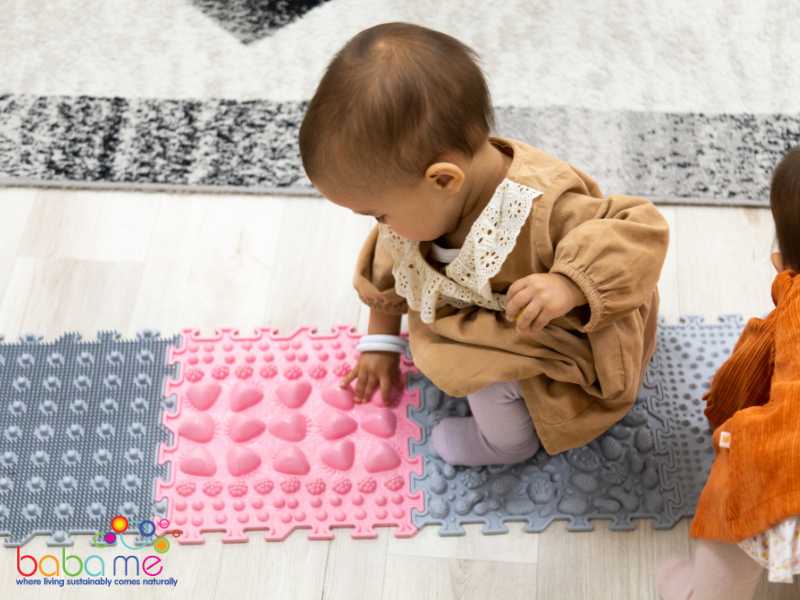
Sensory Walk
For the Sensory child Walk, create a path with different textured materials like bubble wrap, soft towels, cool tiles, grass, or even a squishy mat. Then, encourage your little one to walk barefoot and feel the different textures under their feet. You can even create an obstacle course for them to work their way through which will also help with physical development.
The Sensory Walk provides a unique tactile experience that is both stimulating and exploratory. This activity encourages gross motor skills and balance while introducing the concept of texture. It also boosts cognitive development as your child distinguishes between the various textures.
This activity can also help young toddlers with language skills as you can talk about all the materials and textures as you walk.
Animal Texture Book
Creating an Animal Texture Book involves collecting different textures that mimic animal fur or skin, such as soft fabric for a bunny, rough sandpaper for a lizard, or wool for a sheep. Paste these textures onto the pages of a book and add corresponding animal pictures.
The Animal Texture Book provides a stimulating tactile experience. It’s an exciting way to introduce animals while enhancing your child’s tactile understanding and vocabulary. Plus, turning the pages of the book helps develop fine motor skills.
What Do I Need for Sensory Activities?
Setting up sensory activities for your child doesn’t require a lot of fancy equipment or expensive toys. In fact, most of the materials you need can likely be found around your home or purchased at an affordable price. Here’s a basic list:
Containers: Bins, buckets, trays, or tubs are great for holding sensory materials. They can be filled with water, sand, rice, or any other tactile substances.
Fillers: Items such as sand, water, cooked pasta, rice, shaving cream, or playdough are excellent sensory materials.
Tools: Think about spoons, scoops, tongs, brushes, or even toy cars and trucks. These items help with manipulation and fine motor skills.
Natural Elements: Collect pine cones, leaves, stones, or shells during a nature walk for a fun, tactile experience.
Household Items: Don’t overlook the potential of everyday objects, like straws, cotton balls, toilet paper rolls, bubble wrap other basic household items.
Safety Measures: Always supervise your child during sensory play to prevent choking or other accidents. If your activity includes small parts or potentially hazardous materials, make sure they’re age-appropriate and safe.
Imagination: Perhaps the most crucial ingredient! Create a fun and inviting environment that encourages your child to explore, experiment, and engage with the sensory activities.
FAQs on Activities 18 month old
All of the educational activities are great for 18 months old and will help them hit their key developmental milestones as well as being a fun sensory experience. They can also promote imaginative play, as their creative ideas are allowed to develop, whether on construction paper, or with indoor toddler activities there is plenty to keep your preschooler busy.
What Are Things For 18-Month-Olds To Do?
As they grow up and start walking, they love to play. Introduce them to different kinds of plays and activities. They’re gonna learn and explore these options. Make sure to give time to learn new games one by one.
Why Should We Have Indoor Activities For 18 Months Old?
Indoor activities will help your child build better sensory nerves. Plus, it has huge importance in your child’s development. They need a huge chunk of interesting indoor activities to stay busy with. Hence, these are going to improve all 5 senses of your child.
What Activities Should an 18-Month-Old Be Doing?
At 18 months, activities should encourage motor skills, language development, problem-solving, and social interaction. This can include stacking blocks, drawing, dancing, kicking a ball, and helping with simple tasks like picking up toys.
What Words Should an 18-Month-Old Be Saying?
An 18-month-old typically has a vocabulary of about 20 words. They should be saying common words like “mama,” “dada,” “more,” “no,” and names of familiar people or objects. Every child is different, and some may be saying two-word phrases like “more juice,” while others might still be using single words.
What Should an 18-Month-Old Know Academically?
At this age, academic knowledge isn’t about reading, writing, or math yet. Instead, it’s about exploration and understanding the world. An 18-month-old should be able to follow simple one-step instructions, recognize common objects and pictures in books, sort shapes and colors, and use objects for their intended purpose (like drinking from a cup).
How Do I Entertain My 18-Month-Old Indoors?
Indoor activities for an 18-month-old can include reading together, playing with toys that encourage imaginative play (like a pretend kitchen), building with blocks, dancing to music, or simple craft activities like coloring. Sensory activities, such as playing with playdough, water, or a sensory bin filled with rice or pasta, can also be great fun.
What Do You Do with an 18-Month-Old All Day?
A day with an 18-month-old should include a balance of structured activities, free play, meal times, and naps. Structured activities can include reading, sensory play, or simple crafts. Free play can involve letting your child explore their toys or outdoor space (under supervision). Keep routines like meal times and naps consistent to provide a sense of security and structure. Remember, everyday tasks, like helping to set the table or sorting laundry, can also be great learning opportunities.

